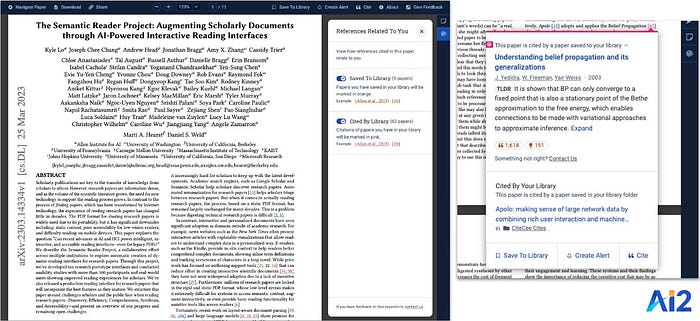Source: https://blog.allenai.org/citesee-e0f9e9d46569
CiteSee: Augmenting Citations in Papers with Persistent and Personalized Historical Context

Inline citations play a crucial role in the scholarly research process, as they allow researchers to contextualize the paper they are reading within the cited work, draw connections among relevant papers, and build up a higher level view of the research fields. A prior work estimated that inline citations account for around 1 in 5 paper discoveries during active research (King et al. 2009). Despite their importance and ubiquity, our preliminary interviews showed that it can be challenging for scholars to prioritize which inline citations to explore, considering the sheer volume of citations they encounter during literature reviews and the varying relevance to a reader’s interests. The most common concern was the fear of overlooking important citations, which could lead to significant research consequences. Additionally, participants expressed difficulties in tracking their progress and retaining context around saved or visited papers.
These findings informed the development of CiteSee, a personalized paper reading tool for in-situ citation sensemaking. CiteSee visually augments citations within scientific papers based on their connections to a user’s research activities to better reflect their research interests and literature review progress. By leveraging a user’s publications, paper library and recent reading history, CiteSee offers a range of visual citation augmentation types.These augmentation types enable users to both prioritize unexplored inline citations most related to their interests during literature reviews (i.e., re-encountered across papers), as well as keeping track of which inline citations were already explored (e.g., visited or saved). In addition, CiteSee also presents persistent and personalized historical context around citations, allowing users to make sense of how a citation connects to them personally. For this, users can further interact with inline citations by clicking on them, revealing personalized contexts in a Paper Card, such as the last time the paper was opened or the citing sentences from across papers they have recently explored. This allows for a more personalized and context-rich understanding of the citations within a paper. By leveraging these core mechanisms, CiteSee effectively supports users in discovering relevant citations, surfacing familiar papers, and providing personalized context around inline citations to aid in conducting literature reviews.
In a lab study, we validate CiteSee’s core functionality of highlighting relevant citations for paper discovery during literature reviews. Participants read a set of papers and actively examined citations to find important prior work, with results showing that CiteSee’s personalized approach significantly outperformed three baselines. We also conducted a field deployment study to further understand CiteSee’s real-world benefits. We recruited participants who had planned to conduct literature reviews and installed on their computers for one to two weeks for a planned literature review. We found that participants were actively engaged with the system, and that the majority of papers they discovered and saved were via highlighted inline citations. In the post-interviews, participants expressed benefits in using CiteSee, with its visual augmentations helping them discover more relevant prior work, remember papers they have examined or encountered in the past, and make sense of common citations across multiple papers, ultimately proving to be a valuable tool in supporting literature review tasks and enhancing understanding of inline citations.
In conclusion, CiteSee is a promising scientific paper reading tool that enhances the literature review process by personalizing the user’s experience and providing contextualized inline citations. By tracking and exploiting the user’s past research activities, CiteSee allows researchers to prioritize highly relevant inline citations during literature reviews and explore additional personalized context to make better sense of them. Our studies demonstrate the advantages of CiteSee over baseline strategies for paper discovery, and the positive impact it has on real-world literature review tasks. As scientific research publications continue to grow rapidly, intelligent reading tools like CiteSee will play a crucial role in helping researchers navigate the vast landscape of existing literature, ensuring they can identify and understand the most relevant and impactful work in their fields and how they relate and build on each other.
CiteSee received the Best Paper Award (1%) in ACM #CHI2023, and we will present this work at the conference in Hamburg, Germany this month. CiteSee is a collaborative effort among researchers from
@ , and including Joseph Chee Chang, Amy X. Zhang, Jonathan Bragg, Andrew Head, Kyle Lo, Doug Downey, and Daniel S. Weld.
You can try CiteSee (beta) today by visiting https://citesee.app or learn more by reading our paper:
Follow @allen_ai and @semanticscholar on Twitter, and subscribe to the AI2 Newsletter to stay current on news and research coming out of AI2.
😉💻🔄 Research Scientist @ AI2/Semantic Scholar | prev @ Carnegie Mellon
No comments:
Post a Comment